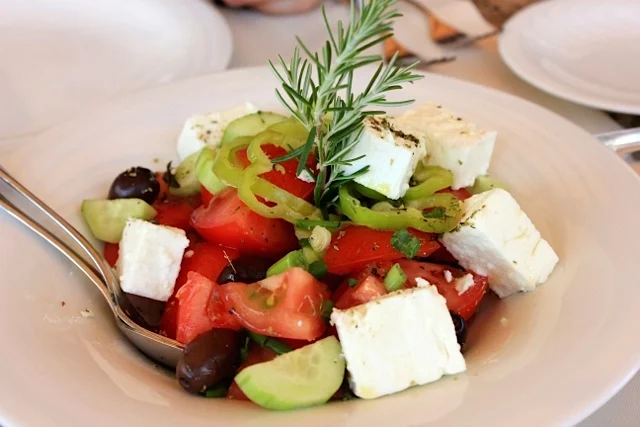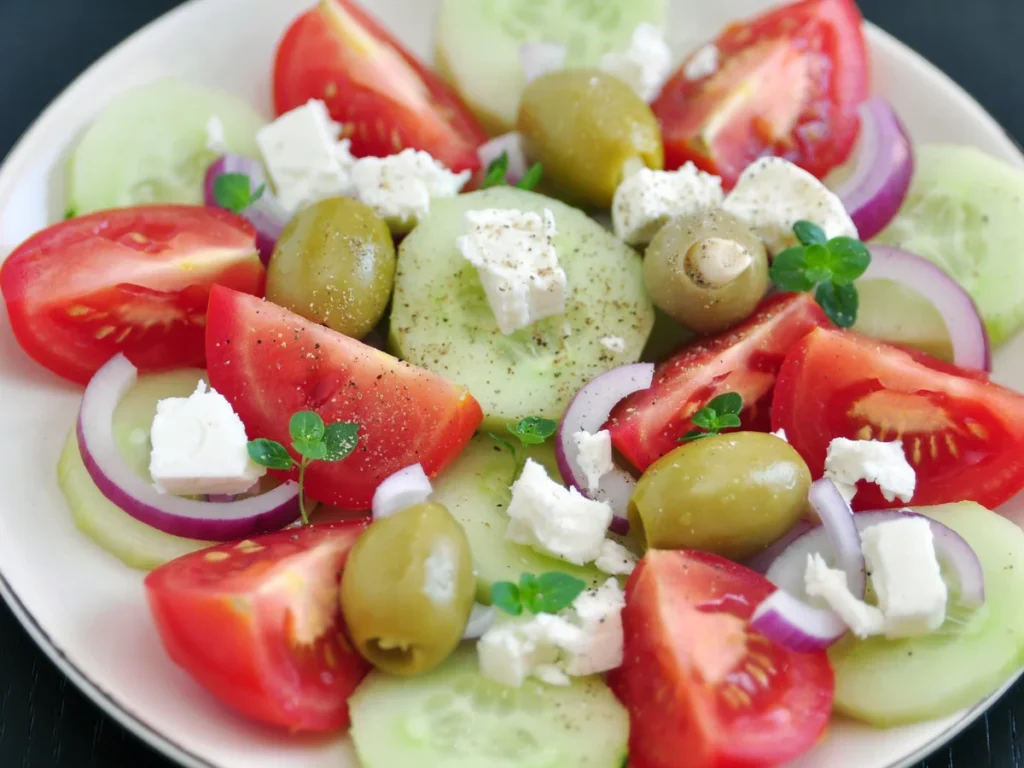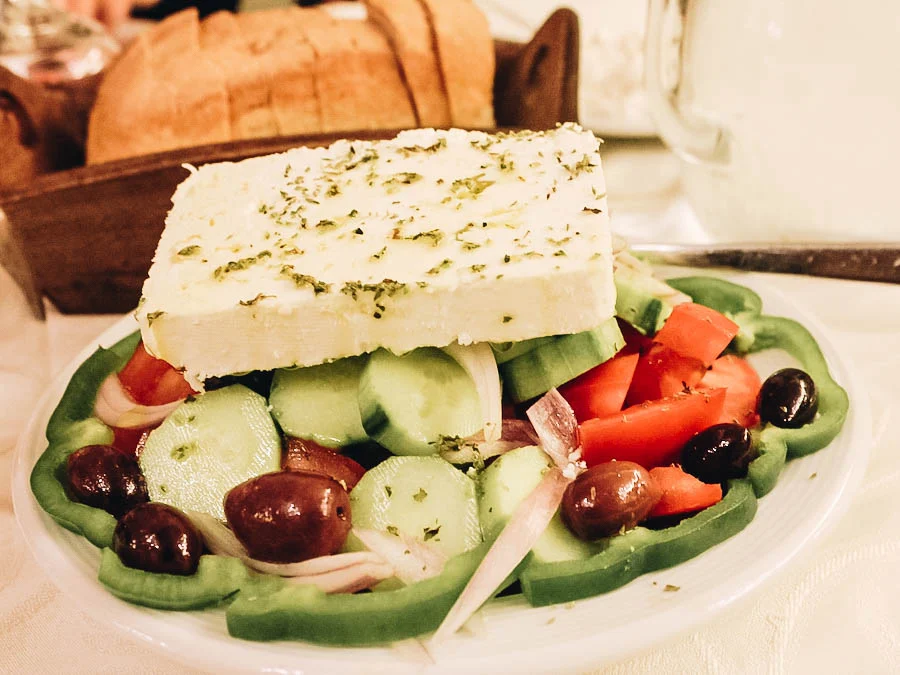When you picture a colorful, healthy, and refreshing salad, Greek salad is often one of the first that comes to mind. With its crisp cucumbers, juicy tomatoes, red onions, olives, and creamy feta cheese, this Mediterranean dish has won hearts across continents.
But one might wonder:
Which country eats the most Greek salad in the world?
Unsurprisingly, the answer is Greece itself. Greek salad—known locally as Horiatiki—is not just a national staple but a symbol of the country’s food culture and Mediterranean lifestyle. However, its popularity doesn’t stop at Greece’s borders. Countries like the United States, Germany, Canada, and Australia are also big fans of this iconic vegetarian salad.
In this article, we’ll explore:
- The history and origins of Greek salad
- Its traditional vegetarian ingredients
- The countries that consume the most Greek salad today
- Global variations that remain meat-free
- Why it’s become a staple in healthy eating around the world
Let’s dig into this colorful and crunchy journey.
The Origins of Greek Salad (Horiatiki)

Greek salad, or Horiatiki salata (meaning “village salad”), is a traditional dish originating in rural Greece. It’s a simple yet vibrant mix of fresh ingredients that reflect the Mediterranean climate and agricultural richness.
Traditional Ingredients:
- Tomatoes – ripe, juicy, and often in wedges
- Cucumbers – peeled or unpeeled, sliced thick
- Red onions – thinly sliced for a mild kick
- Kalamata olives – whole and rich in flavor
- Feta cheese – served in a thick slab on top (never crumbled)
- Green bell pepper – sliced into rings (optional)
- Olive oil – drizzled generously
- Oregano – dried, for a fragrant finish
- Red wine vinegar – for a mild tang (optional)
Importantly, Greek salad contains no lettuce—unlike many Western interpretations.
It’s also naturally vegetarian. No meat, no seafood—just fresh vegetables, cheese, and olive oil. That’s part of why it’s so widely enjoyed across different cultures and dietary preferences.
Why Greece Eats the Most Greek Salad

Greek salad is as common in Greece as bread or olive oil. It’s part of everyday meals, especially in warmer months, and is served in:
- Traditional tavernas (casual Greek restaurants)
- Homes during lunch or dinner
- Cafes, hotels, and even street-side food stalls
Why It’s So Popular in Greece:
- Simplicity and freshness – minimal ingredients, maximum flavor
- Accessibility – vegetables and feta are widely available year-round
- Health benefits – aligns with the Mediterranean diet
- Cultural tradition – a point of pride and culinary identity
According to various Greek food studies, the average person in Greece consumes Greek salad several times per week, especially during summer, when tomatoes and cucumbers are at their peak.
Countries That Love Greek Salad (Besides Greece)

Greek salad’s fame has spread far beyond the Mediterranean, becoming a favorite around the world. Here are some of the biggest global consumers and how they’ve adopted this refreshing dish—without adding meat.
1. United States
Greek salad is a menu staple in diners, salad bars, Mediterranean restaurants, and health-focused cafes. Americans love the combination of feta and olives, and vegetarian eaters gravitate toward it as a satisfying meal without meat.
- Pre-packaged Greek salads are sold widely in grocery stores.
- Many fast-casual restaurants offer customizable bowls based on Greek salad.
- Greek cuisine is growing in popularity, boosting salad demand.
Some American versions include lettuce, but many purists (and chefs) stick to the original Horiatiki style.
2. Germany
Germany has a strong appetite for Mediterranean food, especially Greek. With a large Greek diaspora and thousands of Greek restaurants across the country, Greek salad is frequently ordered alongside vegetarian platters or meze.
- Feta cheese and olives are widely available in German supermarkets.
- The salad is often eaten as a light meal, lunch, or starter.
3. Canada
Canadians love global flavors, and Greek salad fits perfectly into health-conscious dining habits. In multicultural cities like Toronto and Vancouver, Greek and Mediterranean eateries thrive.
- Greek salad is often included in vegetarian meal plans and takeout menus.
- It’s commonly served without any meat add-ons, making it a natural veggie option.
4. Australia
With a strong Greek community, particularly in Melbourne (often called the third-largest Greek city after Athens and Thessaloniki), Greek salad is immensely popular in Australia.
- Served at Greek festivals, homes, and restaurants.
- Often enjoyed as a side dish at barbecues, or as a light main course.
5. United Kingdom
The UK’s evolving food scene embraces Mediterranean dishes, and Greek salad is no exception. It’s common in cafes, health-conscious eateries, and supermarkets.
- The salad is often made vegetarian-friendly, served with hummus, falafel, or couscous.
- Supermarket chains like Tesco and Waitrose sell ready-made Greek salads and feta-based salads with olives.
Global Vegetarian Variations of Greek Salad

As Greek salad has spread, chefs and home cooks around the world have created their own vegetarian interpretations—while staying true to the spirit of freshness and simplicity.
Popular Vegetarian Adaptations:
- Avocado Greek Salad – adds creamy texture and healthy fats
- Chickpea Greek Salad – boosts protein and fiber
- Quinoa Greek Salad – ideal for meal-prep and gluten-free diets
- Watermelon Greek Salad – a summer twist with sweet-and-salty balance
- Tofu-Feta Greek Salad – vegan alternative with similar texture to feta
These versions remain meat-free, while offering variety and global flair.
Greek Salad and the Mediterranean Diet

Greek salad is one of the most iconic representations of the Mediterranean diet, which is considered one of the healthiest in the world.
Health Benefits:
- Rich in antioxidants from tomatoes and olives
- Heart-healthy fats from extra virgin olive oil
- High in fiber and vitamins from raw vegetables
- Calcium and protein from feta cheese
- Low in processed ingredients and additives
It’s no surprise that Greek salad is recommended by dietitians as part of balanced vegetarian and plant-based eating plans.
Why Greek Salad Appeals to Vegetarians Globally
Unlike other traditional salads that require meat or seafood, Greek salad is naturally vegetarian. That makes it incredibly accessible to a wide audience, including:
- Vegetarians
- Flexitarians
- Pescatarians (who skip meat but eat dairy)
- Vegans (with minor substitutions like plant-based feta)
And because it’s easy to make at home using fresh, affordable ingredients, it’s become a global go-to for quick, healthy, meatless meals.
Conclusion: Greece Tops the List, But the Whole World Loves It Meat-Free
So, to answer the question:
Which country eats the most Greek salad in the world?
Greece, hands down—where it’s not just a dish but a way of life.
However, the global love for Greek salad is undeniable. From the cafes of Melbourne to the lunch tables of New York, people are embracing this fresh, flavorful, and vegetarian-friendly classic.
As the world leans more toward plant-based eating, Greek salad is proof that delicious doesn’t need to mean complex—or include meat. With just a handful of simple ingredients, it delivers on taste, nutrition, and cultural connection.





